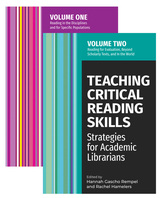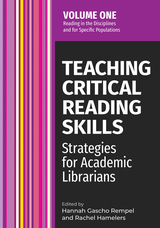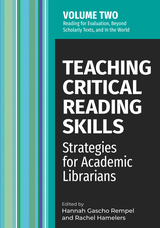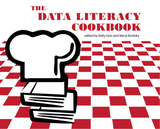183 scholarly books by Assoc of College & Research Libraries and 9
have author last names that start with G
183 scholarly books by Assoc of College & Research Libraries and 9
183 scholarly books by Assoc of College & Research Libraries
9 have author last names that start with G have author last names that start with G
9 have author last names that start with G have author last names that start with G

Teaching Critical Reading Skills
Strategies for Academic Librarians Set: 2-Volume Set
Hannah Gascho Rempel
Assoc of College & Research Libraries, 2023
Teaching Critical Reading Skills: Strategies for Academic Librarians collects the experiences and approaches of librarians who teach reading. In two volumes, librarians share their role in teaching reading—using pedagogical theories and techniques in new and interesting ways, making implicit reading knowledge, skills, and techniques explicit to students, presenting reading as a communal activity, partnering with other campus stakeholders, and leading campus conversations about critical reading. These volumes provide ready-made activities you can add or adapt to your teaching practice. The five sections are arranged by theme:
Volume 1
Volume 2
Each of the 45 chapters contains teaching and programmatic strategies, resources, and lesson plans, as well as a section titled “Critical Reading Connection” that highlights each author’s approach for engaging with the purpose of reading critically and advancing the conversation about how librarians can foster this skill.
Academic librarians and archivists have a long history of engaging with different types of literacy and acting as a bridge between faculty and students. We understand the different reading needs of specific student populations and the affective challenges with reading that are often shared across learner audiences. We know what types of sources are read, the histories—and needed changes—of how authority has been granted in various fields, how students may be expected to apply what they read in future professional or civic settings, and frequently look beyond our local institutions to think about the larger structural and social justice implications of what is read, how we read, and who does the reading.
These volumes can help you make the implicit explicit for learners and teach that reading is both a skill that must be practiced and nurtured and a communal act. Teaching Critical Reading Skills demonstrates librarians’ and archivists’ deep connections to our campus communities and how critical reading instruction can be integrated in a variety of contexts within those communities.
Volume 1
- Part I: Reading in the Disciplines
- Part II: Reading for Specific Populations
Volume 2
- Part III: Reading Beyond Scholarly Texts
- Part IV: Reading to Evaluate
- Part V: Reading in the World
Each of the 45 chapters contains teaching and programmatic strategies, resources, and lesson plans, as well as a section titled “Critical Reading Connection” that highlights each author’s approach for engaging with the purpose of reading critically and advancing the conversation about how librarians can foster this skill.
Academic librarians and archivists have a long history of engaging with different types of literacy and acting as a bridge between faculty and students. We understand the different reading needs of specific student populations and the affective challenges with reading that are often shared across learner audiences. We know what types of sources are read, the histories—and needed changes—of how authority has been granted in various fields, how students may be expected to apply what they read in future professional or civic settings, and frequently look beyond our local institutions to think about the larger structural and social justice implications of what is read, how we read, and who does the reading.
These volumes can help you make the implicit explicit for learners and teach that reading is both a skill that must be practiced and nurtured and a communal act. Teaching Critical Reading Skills demonstrates librarians’ and archivists’ deep connections to our campus communities and how critical reading instruction can be integrated in a variety of contexts within those communities.
[more]

Teaching Critical Reading Skills v1
Strategies for Academic Librarians Volume 1
Hannah Gascho Rempel
Assoc of College & Research Libraries, 2023
Teaching Critical Reading Skills: Strategies for Academic Librarians collects the experiences and approaches of librarians who teach reading. In two volumes, librarians share their role in teaching reading—using pedagogical theories and techniques in new and interesting ways, making implicit reading knowledge, skills, and techniques explicit to students, presenting reading as a communal activity, partnering with other campus stakeholders, and leading campus conversations about critical reading. These volumes provide ready-made activities you can add or adapt to your teaching practice. The five sections are arranged by theme:
Volume 1
Volume 2
Each of the 45 chapters contains teaching and programmatic strategies, resources, and lesson plans, as well as a section titled “Critical Reading Connection” that highlights each author’s approach for engaging with the purpose of reading critically and advancing the conversation about how librarians can foster this skill.
Academic librarians and archivists have a long history of engaging with different types of literacy and acting as a bridge between faculty and students. We understand the different reading needs of specific student populations and the affective challenges with reading that are often shared across learner audiences. We know what types of sources are read, the histories—and needed changes—of how authority has been granted in various fields, how students may be expected to apply what they read in future professional or civic settings, and frequently look beyond our local institutions to think about the larger structural and social justice implications of what is read, how we read, and who does the reading.
These volumes can help you make the implicit explicit for learners and teach that reading is both a skill that must be practiced and nurtured and a communal act. Teaching Critical Reading Skills demonstrates librarians’ and archivists’ deep connections to our campus communities and how critical reading instruction can be integrated in a variety of contexts within those communities.
Volume 1
- Part I: Reading in the Disciplines
- Part II: Reading for Specific Populations
Volume 2
- Part III: Reading Beyond Scholarly Texts
- Part IV: Reading to Evaluate
- Part V: Reading in the World
Each of the 45 chapters contains teaching and programmatic strategies, resources, and lesson plans, as well as a section titled “Critical Reading Connection” that highlights each author’s approach for engaging with the purpose of reading critically and advancing the conversation about how librarians can foster this skill.
Academic librarians and archivists have a long history of engaging with different types of literacy and acting as a bridge between faculty and students. We understand the different reading needs of specific student populations and the affective challenges with reading that are often shared across learner audiences. We know what types of sources are read, the histories—and needed changes—of how authority has been granted in various fields, how students may be expected to apply what they read in future professional or civic settings, and frequently look beyond our local institutions to think about the larger structural and social justice implications of what is read, how we read, and who does the reading.
These volumes can help you make the implicit explicit for learners and teach that reading is both a skill that must be practiced and nurtured and a communal act. Teaching Critical Reading Skills demonstrates librarians’ and archivists’ deep connections to our campus communities and how critical reading instruction can be integrated in a variety of contexts within those communities.
[more]

Teaching Critical Reading Skills v2
Strategies for Academic Librarians Volume 2
Hannah Gascho Rempel
Assoc of College & Research Libraries, 2023
Teaching Critical Reading Skills: Strategies for Academic Librarians collects the experiences and approaches of librarians who teach reading. In two volumes, librarians share their role in teaching reading—using pedagogical theories and techniques in new and interesting ways, making implicit reading knowledge, skills, and techniques explicit to students, presenting reading as a communal activity, partnering with other campus stakeholders, and leading campus conversations about critical reading. These volumes provide ready-made activities you can add or adapt to your teaching practice. The five sections are arranged by theme:
Volume 1
Volume 2
Each of the 45 chapters contains teaching and programmatic strategies, resources, and lesson plans, as well as a section titled “Critical Reading Connection” that highlights each author’s approach for engaging with the purpose of reading critically and advancing the conversation about how librarians can foster this skill.
Academic librarians and archivists have a long history of engaging with different types of literacy and acting as a bridge between faculty and students. We understand the different reading needs of specific student populations and the affective challenges with reading that are often shared across learner audiences. We know what types of sources are read, the histories—and needed changes—of how authority has been granted in various fields, how students may be expected to apply what they read in future professional or civic settings, and frequently look beyond our local institutions to think about the larger structural and social justice implications of what is read, how we read, and who does the reading.
These volumes can help you make the implicit explicit for learners and teach that reading is both a skill that must be practiced and nurtured and a communal act. Teaching Critical Reading Skills demonstrates librarians’ and archivists’ deep connections to our campus communities and how critical reading instruction can be integrated in a variety of contexts within those communities.
Volume 1
- Part I: Reading in the Disciplines
- Part II: Reading for Specific Populations
Volume 2
- Part III: Reading Beyond Scholarly Texts
- Part IV: Reading to Evaluate
- Part V: Reading in the World
Each of the 45 chapters contains teaching and programmatic strategies, resources, and lesson plans, as well as a section titled “Critical Reading Connection” that highlights each author’s approach for engaging with the purpose of reading critically and advancing the conversation about how librarians can foster this skill.
Academic librarians and archivists have a long history of engaging with different types of literacy and acting as a bridge between faculty and students. We understand the different reading needs of specific student populations and the affective challenges with reading that are often shared across learner audiences. We know what types of sources are read, the histories—and needed changes—of how authority has been granted in various fields, how students may be expected to apply what they read in future professional or civic settings, and frequently look beyond our local institutions to think about the larger structural and social justice implications of what is read, how we read, and who does the reading.
These volumes can help you make the implicit explicit for learners and teach that reading is both a skill that must be practiced and nurtured and a communal act. Teaching Critical Reading Skills demonstrates librarians’ and archivists’ deep connections to our campus communities and how critical reading instruction can be integrated in a variety of contexts within those communities.
[more]

The Data Literacy Cookbook
Kelly Getz
Assoc of College & Research Libraries, 2022
Today’s students create and are confronted with many kinds of data in multiple formats. Data literacy enables students and researchers to access, interpret, critically assess, manage, handle, and ethically use data.
The Data Literacy Cookbook includes a variety of approaches to and lesson plans for teaching data literacy, from simple activities to self-paced learning modules to for-credit and discipline-specific courses. Sixty-five recipes are organized into nine sections based on learning outcomes:
The Data Literacy Cookbook includes a variety of approaches to and lesson plans for teaching data literacy, from simple activities to self-paced learning modules to for-credit and discipline-specific courses. Sixty-five recipes are organized into nine sections based on learning outcomes:
- Interpreting Polls and Surveys
- Finding and Evaluating Data
- Data Manipulation and Transformation
- Data Visualization
- Data Management and Sharing
- Geospatial Data
- Data in the Disciplines
- Data Literacy Outreach and Engagement
- Data Literacy Programs and Curricula
[more]

Interdisciplinarity And Academic Libraries
ACRL 66
Craig Gibson
Assoc of College & Research Libraries, 2012

Building Teaching and Learning Communities
Creating Shared Meaning and Purpose
Craig Gibson
Assoc of College & Research Libraries, 2019

Navigating The Future With Sce Nario Planning
A Guidebook Fo
Joan Giesecke
Assoc of College & Research Libraries, 2015

Navigating the Future with Scenario Planning
A Guidebook for Librarians
Joan Giesecke
Assoc of College & Research Libraries, 2015

Disciplinary Applications of Information Literacy Threshold Concepts
Samantha Godbey
Assoc of College & Research Libraries, 2017
READERS
Browse our collection.
PUBLISHERS
See BiblioVault's publisher services.
STUDENT SERVICES
Files for college accessibility offices.
UChicago Accessibility Resources
home | accessibility | search | about | contact us
BiblioVault ® 2001 - 2024
The University of Chicago Press









